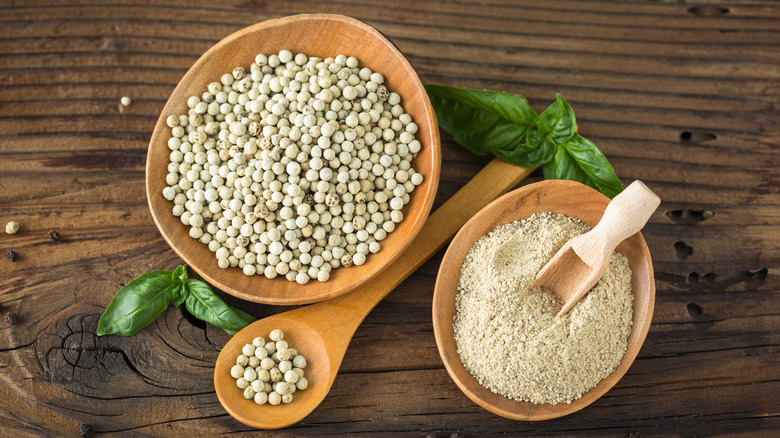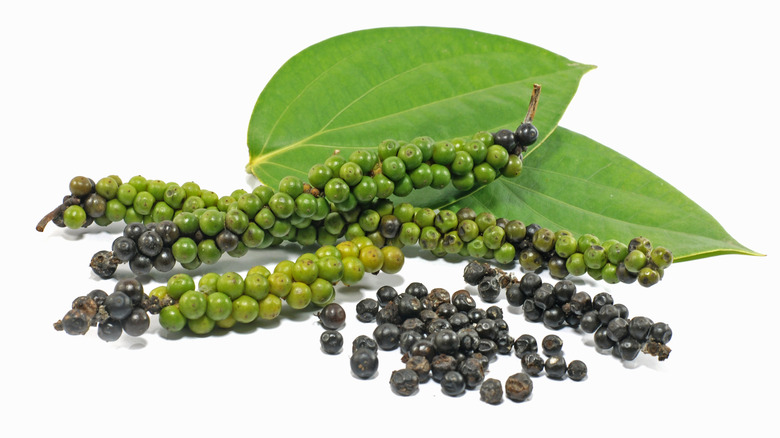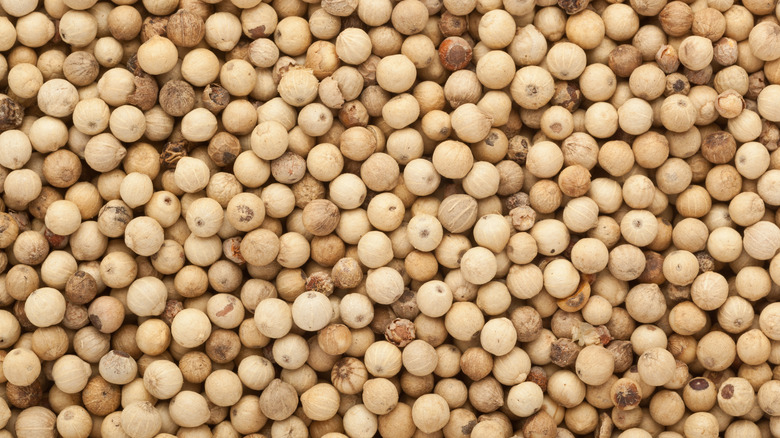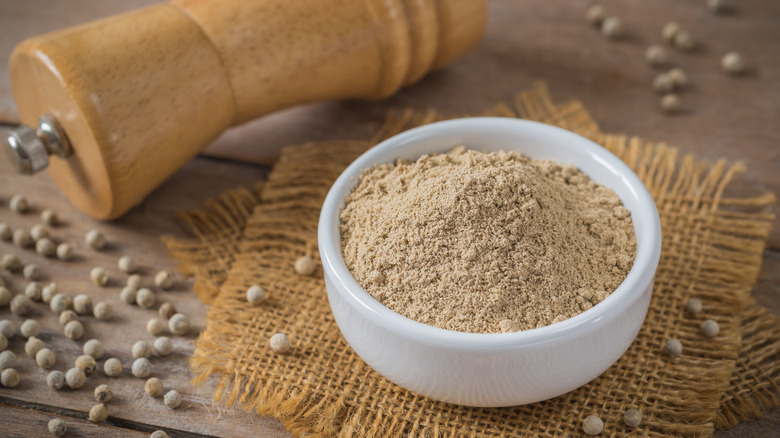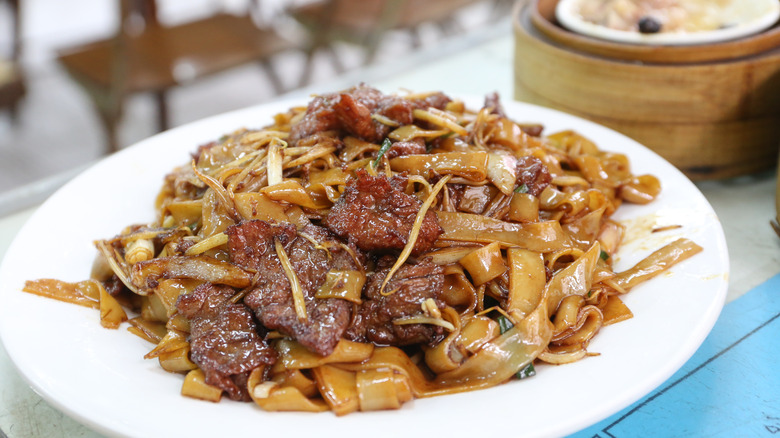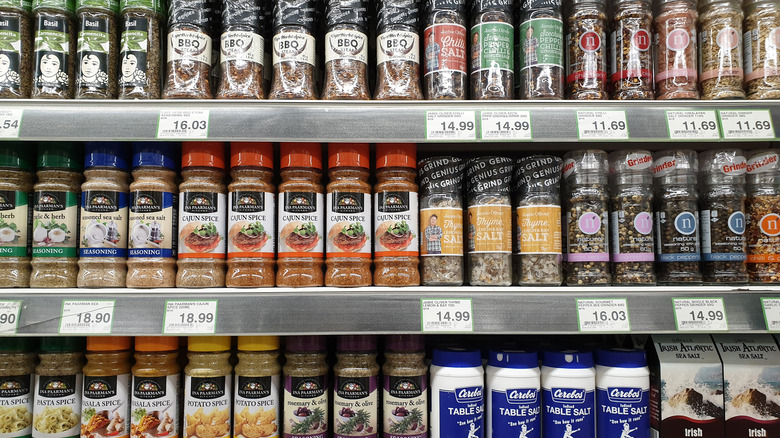Amplify Umami Flavors With Fermented White Pepper
White pepper is normally used as an alternative to black pepper, particularly when you want to spice up a dish, but don't want to break up a white or cream sauce with flecks of color, per Gourmetpedia. While cooks might be happy to use plain white pepper this way, there is another type of white pepper that isn't content to sit on the sidelines to wait for its chance to shine.
Fermented white pepper is its own spice, and it is not used as a substitute for black pepper, because its flavor profile is so different. Unlike plain white pepper, fermented white pepper comes loaded with umami, and shines when it is used in Cantonese and Southeast Asian cooking, per SemiFinalist. The difference between plain white pepper and its fermented alter ego lies in the way its source — the piper nigrum berry — is treated after it is harvested.
How fermented white pepper is made
Ethan Frisch, who runs the high-end spice trading company Burlap and Barrel, tells Tasting Table that both types of white pepper — plain and fermented — start out the same way.
He explains that black pepper and white pepper come from the same plant, the piper nigrum. Peppercorns (also called pepper berries) are the fruit of the piper nigrum plant. Black peppercorns are simply dried after harvesting, but to make white pepper, the skin of the peppercorn or the pepper berry is removed. This is done by soaking the fresh peppercorns in water until the fruit softens and the skin can be removed.
For plain white pepper, the pepper berries are soaked for just a few days (per Taste), but, in the case of fermented white pepper, Frisch explains that piper nigrum berries are placed in woven sacks and soaked for up to a couple of weeks. Bon Appétit says 10 to 14 days, specifically. Frisch says that during this time the sugars in the peppercorn fruit start to ferment, which you can actually see happen as small streams of bubbles rise up from the peppercorn sacks. Once the peppercorns are retrieved, they are then rubbed against a rough surface (usually a screen or a slotted bowl) to get rid of any leftover fruit. Finally, they are then left in the sun to dry.
Plain white pepper vs. fermented white pepper
The main differences between plain white pepper and fermented white pepper are a result of the length of time they are left to soak. For plain white pepper, the peppercorns are only soaked a few days and don't ferment, resulting in two white peppers with very different flavors and aromas.
Martha Stewart describes the taste of plain white pepper as grassy and musty. The spice, which is also called earthy and cheesy, is sometimes considered less sophisticated than black pepper as some of its piperine compound and oils are removed during the soaking process, which black and green pepper berries don't undergo, according to Lafayette Spices. Still, the soft heat of white pepper is often preferred when the cook wants the pepper to combine well with other flavors.
But fermented white pepper has a completely different taste altogether. The fermentation process is said to leave the resulting spice with a richer odor and flavor profile. So even though fermented white pepper has been stripped of some of its piperine, it still has a distinctive aroma which some spice experts have described as "funky," per Taste. Chef Adrienne Cheatham says the first time he ground fermented white peppercorns he was surprised, per The Washington Post. "It kind of smells like feet," he says.
Both types of white pepper have their fans. Plain white pepper is developed for a western market, where it is primarily used to perk up dishes made with cream sauces, where the spice can be tasted but not seen, per McCormick, while the fermented style is prized in East Asian and Southeast Asian cooking.
What does fermented white pepper taste like?
Fermented white pepper has a flavor that is best described as "umami," and one that is best paired with stronger flavors seen in many East and Southeast Asian dishes. Bunyaad Marketplace, which provides tasting notes for the spice, describes it as a mix of "goat cheese and celery" and recommends that it is used in place of black pepper, and when there is a need for a "funky kick" to a dish.
Burlap and Barrel's Frich tells Tasting Table, "Fermented white pepper is much more popular in Asia than in the rest of the world ... People really appreciate the funky flavor and heat! You'll find it (in varying degrees of quality) everywhere from a neighborhood congee spot to high-end banquet houses."
How to cook with fermented white pepper
Because of its "funkiness," fermented white pepper can be used to provide the elusive note that stands up to the stronger flavors seen in ingredients like shrimp paste and fish sauce with is used in so many Thai dishes, per Taste. The Mala Market also says the flavor of fermented white pepper is what fans of Cantonese food will remember when they pick up a bowl of hot and sour soup, or when they enjoy a serving of beef chow fun.
When speaking with Taste, Burlap and Barrel's Frisch says that fermented white pepper doesn't do well when paired with dishes that need mild flavors. Instead, it excels when called upon to spice up robust dishes like dry-aged steak. It also goes well with turmeric and cumin, per Bunyaad Marketplace, which also recommends using the spice to add a kick to blended vegetable soups.
How and where can you buy fermented white pepper?
White pepper can be found in most grocery stores across the country but it might be worth reading labels carefully to ensure you are getting what you want, particularly since there are two varieties on the market today. Burlap & Barrel says it's generally difficult to find fermented white pepper in the United States though, so the white pepper found in most supermarkets is likely the plain white pepper.
But, if you're holding a bottle of white pepper at the grocery store, wondering if it's fermented or not, look for its country of origin on the label. Burlap & Barrel's Ethan Frisch points out that European-style white pepper is mostly grown in, and sold out of India, per Taste, while Burlap & Barrel only carries fermented white pepper, which comes from Indonesia, and is indicated as such on its label.
To find good quality white pepper, Bon Appétit says to look for whole white pepper that is creamy white, uniform in size, and without any specks of black or grey that are visible to the naked eye. These tricks will help you find the highest quality white pepper, whichever style you're looking for.
